Bird beaks come in a variety of shapes, sizes, and colors.
And according to research published in the Journal of Evolutionary Biology, beak color functions as a social, not a sexual signal, as it was long presumed.
Many birds face intense competition during breeding and non-breeding periods; colorful bills became an evolutionary adaptation to showcase dominance and fighting ability to others so the contests are settled quickly, without resorting to physical combat.
So what are some of these dominant birds with orange beaks?
When it comes to birds with the orange color of their beaks, the list is extensive. Northern cardinals, violet turacos, many species of terns (like the royal tern), puffins, well-known toco toucans, geese, some hornbills, and waxbills, are just a few.
Let’s jump straight in and see what over 40 species of orange-billed birds look like.
Table of Contents
Birds With Orange Beaks
Northern Cardinal

Scientific name: Cardinalis cardinalis
Lifespan: 3 years
Wingspan: 10-12 in
Beak Color: Orange-red
Found In: the United States and Central America
The northern cardinal, also known as the redbird, is a medium-sized songbird with a prominent crest and a short, very thick, and vibrant orange beak.
Male and female cardinals are easy to differentiate – males are completely red and have reddish beaks, while females are pale brown with clear orange beaks. Both sexes have distinctive, feathered head crests.
Northern cardinals are classified as granivorous because they mostly feed on seeds. Male cardinals got their red color from carotenoids in their food; if not enough of this pigment-triggering food is available, they become brownish.
Northern cardinals mate for life and males sometimes have baldness problems – it’s a sign they’re in the middle of a late summer molt.
These red birds with orange beaks can be found throughout the eastern United States, Mexico, and Central America.
They are state birds of seven U.S. states: Illinois, Indiana, Kentucky, North Carolina, Ohio, Virginia, and West Virginia. Those are some places where you can find it.
Violet Turaco
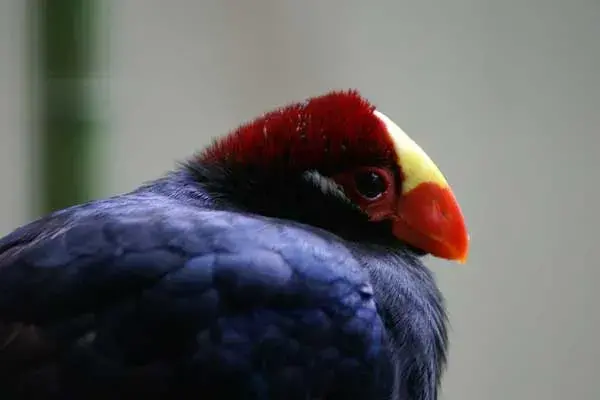
Scientific name: Musophaga violacea
Lifespan: up to 30 years
Wingspan: 8-9 in
Beak Color: Bright orange
Found In: West Africa
The violet turaco, also known as the Violet Plantain-eater, is a large bird that got the name for its rich purple plumage. It has crimson wing and head patches that come from a copper-based pigment called the “turacine”, giving it the name “turaco”.
Violet turacos are easy to recognize by the crimson on their heads, yellow foreheads, and bright orange beaks.
Violet turacos are omnivores that feed on fruits, leaves, buds, flowers, seeds, insects, snails, and slugs. These blue and red birds mostly inhabit tropical savannas, wetlands, woodlands, and forests.
Large Green Barbet
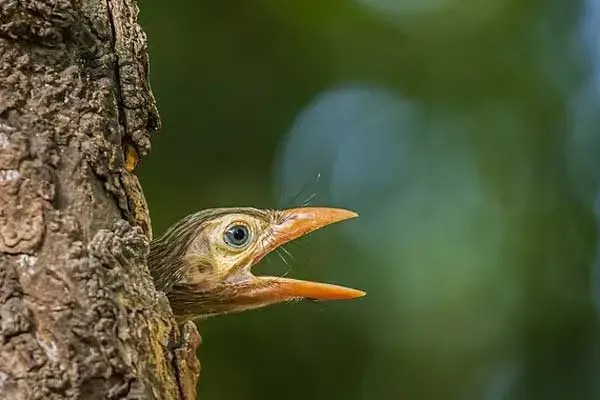
Scientific name: Megalaima zeylanica
Lifespan: n/a
Wingspan: n/a
Beak Color: Dark orange (reddish)
Found In: Asia (Indian subcontinent)
Large green barbet, also known as the brown-headed barbet, is a fruit and insect-eating Asian bird found in India and Sri Lanka. It has prominent pale streaks on its brown head and breast, a yellow eye patch, and green plumage. Its bill is thick, long, and orange to reddish-orange.
It is mostly a non-migratory bird that will occasionally during winter move from higher altitudes to lower elevations and plains.
Royal Tern
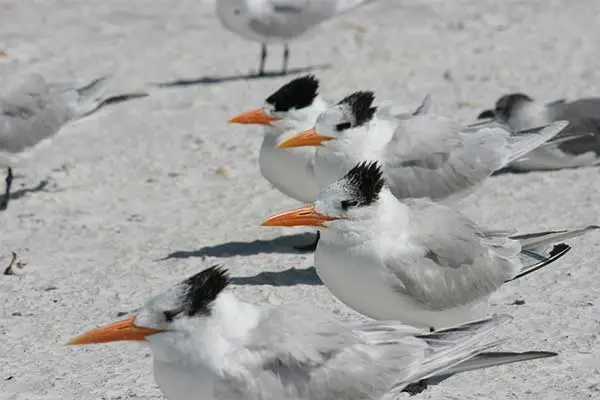
Scientific name: Thalasseus maximus
Lifespan: up to 30 years
Wingspan: 40-50 in
Beak Color: Bright orange
Found In: North America, South America, West Africa
The Royal tern is a large seabird with short legs, gray-white plumage, a black crest on its head, and a bright orange bill. It can be found in Europe, the Americas, and the Caribbean islands, in warm coastal marine waters.
Royal terns are carnivores that feed on small fish, shrimp, and crustaceans. A flock of Royal Terns is known as a “highness”.
In the USA, you can see them in Florida.
Atlantic Puffin

Scientific name: Fratercula arctica
Lifespan: 20-30 years
Wingspan: 19-25 in
Beak Color: Multicolored (orange, black, yellow)
Found In: North Atlantic Ocean (North America and Europe)
Atlantic puffin, also known as the common puffin, is a short diving seabird that has black plumage on its uppersides and white on its chest and belly. Its face and cheeks are white, its webbed feet are orange, and the puffin’s bill is black, orange, and yellow.
The Atlantic puffin is a carnivore that feeds on small fish like the sand eels, herring, hake, and capelin. Because of their parrot-like beak, Atlantic puffins are also called the “sea parrots”.
These black and white birds with orange beaks are short-distance migrants and excellent fliers – puffins can flap their wings up to 400 times per minute!
Toco Toucan
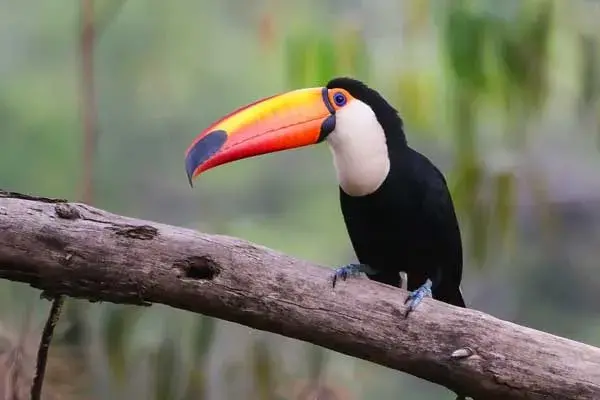
Scientific name: Ramphastos toco
Lifespan: 20 years
Wingspan: 40-60 in
Beak Color: Bright and dark orange
Found In: South America
Toco toucan, also known as a giant toucan, is the largest and most famous species of the toucan family. It has a black body, white throat, and orange skin around its eyes. Toco toucan’s beak is over 7 inches long and has a bright orange color.
Although it seems massive, the beak is actually very light because it is made of keratin and it’s hollow. And when they sleep, toucans tuck their beak under their feathers to keep them warm.
They are not very good fliers and mainly travel among trees by hopping. Toco toucans are omnivores and can be found in the semi-open habitats of central and eastern South America.
Greylag Goose
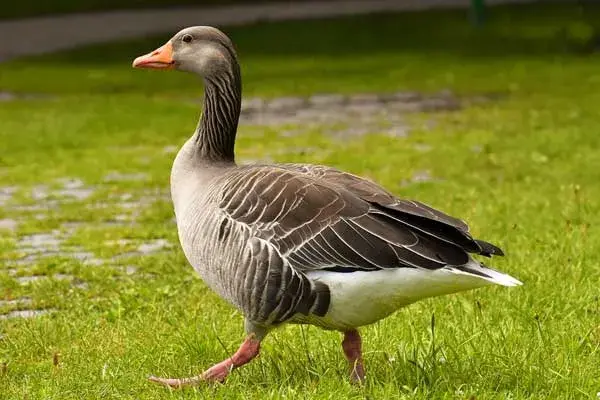
Scientific name: Anser anser
Lifespan: 20 years
Wingspan: 58-71 in
Beak Color: Orange-pink
Found In: Europe
The greylag goose is the largest breed of wild goose. It is native to the British Isles and is easy to recognize by its grey and white plumage, orange beak, and pink legs. It has been domesticated at least as early as 1360 BC.
Greylag geese are diurnal animals that are excellent runners and swimmers – they can run and swim rapidly and escape predators without difficulty. They are herbivores that feed on leaves, berries, water plants, glean grain, etc.
Greylag geese are monogamous, they mate for life, and can be found around parks, gravel pits, river valleys, even small ponds and lakes.
Mute Swan

Scientific name: Cygnus olor
Lifespan: 15-20 years
Wingspan: 79-94 in
Beak Color: Orange with a black base
Found In: North America
The mute swan is a large waterbird with completely white plumage and a bill that is orange with a black base. The black part at the base of the males’ bills swells during the breeding season.
Mute swans are native to Europe and parts of Asia but can be found in the USA as well (especially in California, Arizona, Idaho, and Oregon). They are the national bird of Denmark.
Mute swans got the name ‘mute’ because they are less vocal than other swan species. They are omnivores and feed on aquatic plants, seeds, insects, and sometimes small fish.
Crested Auklet
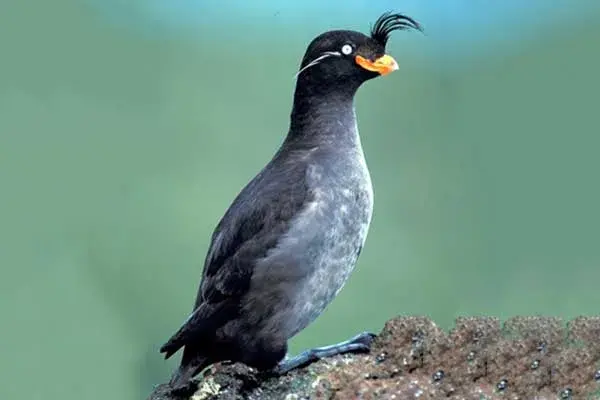
Scientific name: Aethia cristatella
Lifespan: 8-10 years
Wingspan: 13-20 in
Beak Color: Bright orange
Found In: Northern Pacific Ocean and the Bering Sea
The crested auklet is a dark brown-black stocky seabird with a crest of feathers on the top of its head. It is a small bird with a thick, short, and orange bill. People describe it as a smiling clown that never blinks and smells like a tangerine.
Crested auklet is native to the United States, Japan, and Russia. These birds are planktivores and feed on krill, copepods, pteropods, etc.
Read More: List of waterbirds that have black plumage
Rainbow Lorikeet
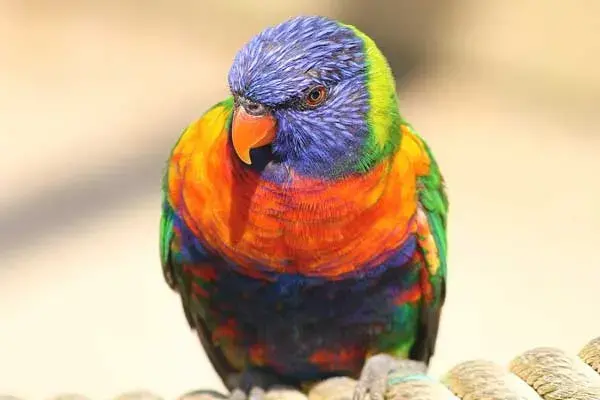
Scientific name: Trichoglossus moluccanus
Lifespan: 20 years
Wingspan: 7 in
Beak Color: Orange (adults)
Found In: Australia
The rainbow lorikeet is a small brightly colored parrot found in Australia. It has a bright yellow-orange breast, violet-blue throat, and a yellow-green collar. Adult lorikeets have orange beaks while the juvenile birds hatch with black ones.
They are friendly and intelligent birds with a population of over 5 million. Rainbow lorikeets are omnivores that mostly eat nectar, pollens, fruits, berries, blossoms, and buds. They might eat insects occasionally. Rainbow lorikeets can be found in woodlands, rainforests, and urban areas with many trees.
Cattle Egret

Scientific name: Bubulcus ibis
Lifespan: 16-23 years
Wingspan: 3 ft
Beak Color: Bright orange
Found In: Africa, North America, Europe
A cattle egret is a small heron with short legs, a thick neck, and a dull orange bill and legs. The cattle egret got its name for the habit of following cattle and other large animals. Adults have white plumage that becomes golden on their heads, chests, and backs during the breeding period.
Some populations of cattle egrets are highly-migratory and will move to North Africa and Asia during the winter. They feed on land insects, worms, frogs, lizards, and small mammals.
American White Pelican
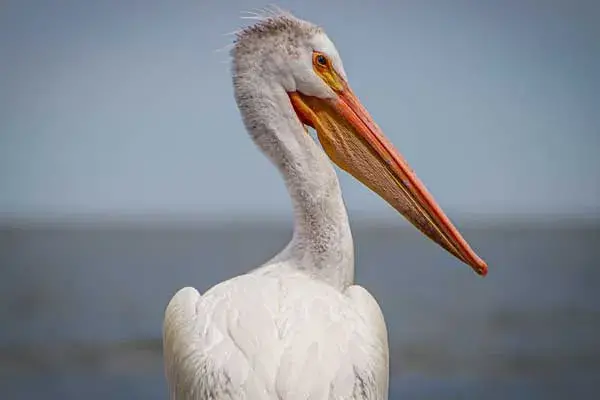
Scientific name: Pelecanus erythrorhynchos
Lifespan: 16-30 years
Wingspan: 95-120 in
Beak Color: Vivid orange
Found In: North America
The American white pelican is a large aquatic bird that lives in inland shallow freshwater lakes, wet prairies, and marshes in the summer and on coastal lagoons in the winter. It has white plumage and black flight feathers visible only when the wings are spread.
American pelican also has vivid yellow-orange bill and legs.
American pelicans can weigh as much as 30 pounds and a group of them is called a “brief”. They breed in North America and move south to Central and South America in winter.
Read More: Black colored birds with yellow beaks
White-Throated Kingfisher
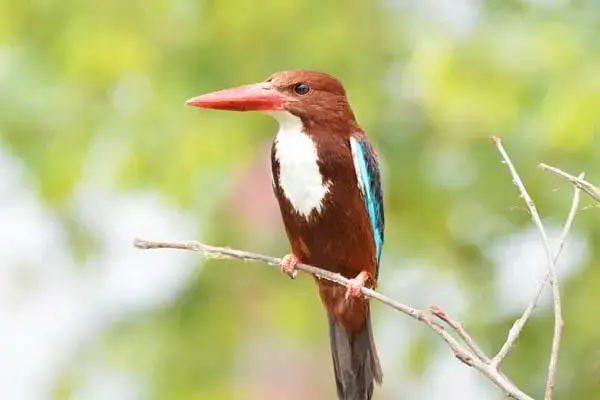
Scientific name: Halcyon smyrnensis
Lifespan: 5 years
Wingspan: 16 in
Beak Color: Heavy orange-red
Found In: Asia
The white-throated kingfisher, also known as the white-breasted kingfisher, is a large brown bird with bright blue wings, back, and tail. It has a large brown head and thick heavy orange bill.
It can be found near wetlands, lakes, agricultural fields, and clearings in Asia, from the Sinai east through the Indian subcontinent to the Philippines.
White-throated kingfishers are very aggressive towards their own kind as well as other kingfisher species.
These brown birds with orange beaks are carnivores that feed on fish, crabs and prawns, lizards, small snakes, insects, tadpoles, and earthworms.
American Oystercatcher
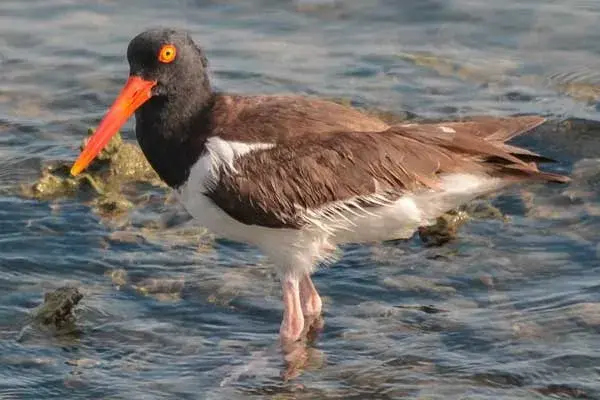
Scientific name: Haematopus palliatus
Lifespan: 10-14 years
Wingspan: 35 in
Beak Color: Vivid orange-red
Found In: Atlantic coast of North America
The American oystercatcher is a large shorebird found on the Atlantic and Gulf Coast beaches. It has distinctive black and white plumage, red-yellow eyes, and a long, bright orange beak.
The beak is razor-sharp and the animal uses it to pry open oysters and other bivalves for food, hence the name “oystercatcher”.
Oystercatchers are social birds that can be often seen during the day foraging, preening, resting, and sunbathing.
Common Blackbird
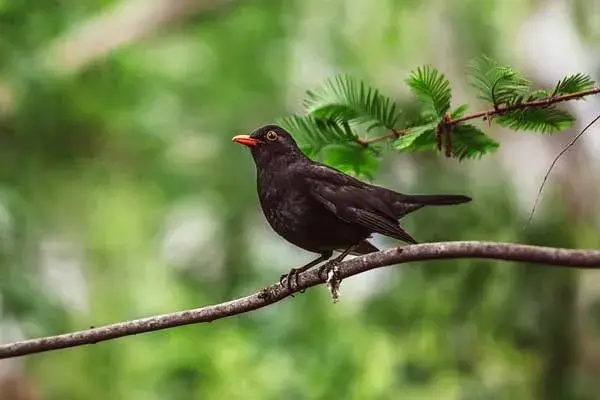
Scientific name: Turdus merula
Lifespan: 4 years
Wingspan: 15 in
Beak Color: Orange (males), brown (females)
Found In: Europe and Asia
The common blackbird is a small wild bird found in wooded habitats, parks, gardens, and farmlands with hedges. Males have fully black plumage and bright golden-orange beaks. Females are brown with reddish-brown breasts.
Common blackbirds are omnivores that feed on worms, fruits, and seeds. Scientists estimate that there are between 160 to 500 million of these small black birds with orange beaks.
Read More: Blackbirds with blue heads
Inca Tern

Scientific name: Larosterna inca
Lifespan: 2-3 years
Wingspan: 12 in
Beak Color: Bright red-orange
Found In: Peru and Chile
The Inca tern is a large tern living in the habitat ruled by the ancient Inca Empire in South America. It has a dark gray plumage, white mustaches on its face, and a bright orange beak and legs.
The mustache is the health sign of the tern – the longer it is, the healthier the bird. Inca terns are piscivores that feed on fish, plankton, shrimp, crayfish, crab, etc.
They are kleptoparasitic – Inca terns steal food from other animals like sea lions and dolphins.
Inca terns are also on our list of 25+ black-colored birds that have white spots on their feathers.
Bank Myna
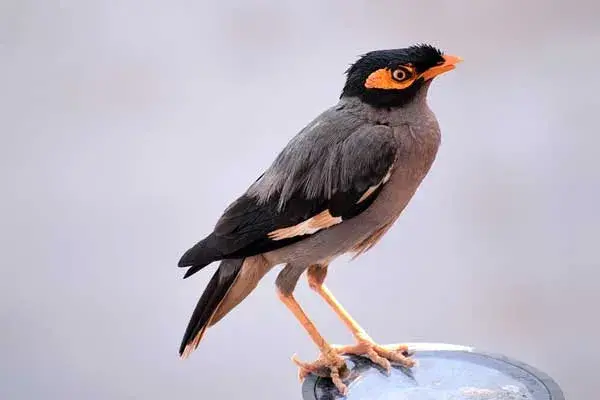
Scientific name: Acridotheres ginginianus
Lifespan: 12-25 years
Wingspan: 18 in
Beak Color: Vivid orange
Found In: South Asia
The bank myna is a medium-sized bird found in the northern parts of South Asia. It has a gray body, dark head and wings, and bright orange face and bill.
Bank myna got its name for the habit of nesting on river banks. It is an omnivore and feeds on animal food, fruit, seeds, and food waste.
Black-Breasted Thrush
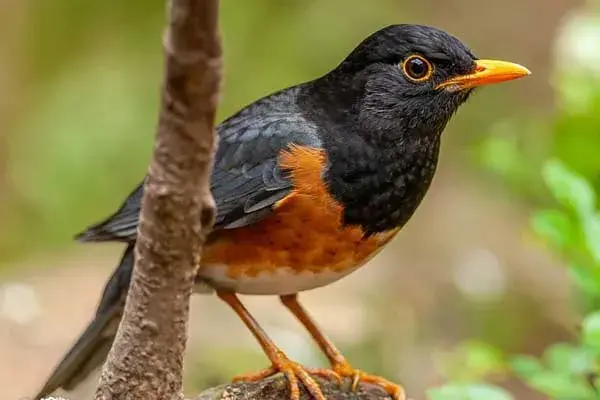
Scientific name: Turdus dissimilis
Lifespan: n/a
Wingspan: n/a
Beak Color: Yellowish-orange
Found In: India and Vietnam
The black-breasted thrush is a forest bird found from north-eastern India to northern Vietnam. Males and females have the same underpart colors; males are black on top while females are mostly gray-brown.
These thrushes have legs, feet, and bills that are orange-yellow. They are omnivores that feed on insects, mollusks, and berries. The call of the black-breasted thrush has been described as “sweet mellow” and “melodious”, with their musical phrases spanning 3–8 notes.
Read More: Incredible birds with split tails
Zebra Finch

Scientific name: Taeniopygia guttata
Lifespan: 2-7 years
Wingspan: 8-9 in
Beak Color: Red-orange
Found In: Central Australia
The Zebra finch is a small songbird found in Central Australia. Male zebra finches have black and white bars on the throat and breast, orange cheeks, and brown on the sides of their bodies. Females are gray-colored in those spots. They also have ‘zebra-like’ patterns on the rump and upper tails.
Males have beaks that range from light orange to dark red. A study published in the Behavioral Biology Journal discovered that zebra finch females prefer red-beaked males to orange ones because redness correlates with good health.
They are excellent pets and social birds that should be kept in pairs. Males will dance to impress the females and they often mate for life.
Intermediate Egret
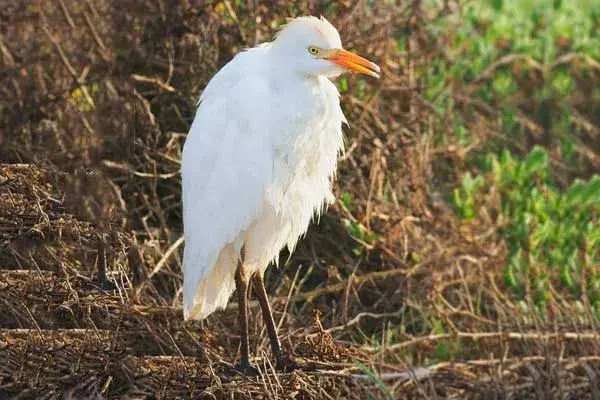
Scientific name: Ardea intermedia
Lifespan: 10-15 years
Wingspan: 41-45 in
Beak Color: Yellow-orange
Found In: Asia, Africa, and Australia
The intermediate egret is a medium-sized white heron with a rounded head and orange-brown eyes. The bill is long and reddish with a yellow-orange tip.
This white bird with an orange beak got its name because it is intermediate in size between the Great Egret and the Little Egret.
Intermediate egret is native to southeastern Asia, Africa, and Australia and feeds on fish, crustaceans, and insects.
American Robin

Scientific name: Turdus migratorius
Lifespan: 2 years
Wingspan: 12-16 in
Beak Color: Bright orange-yellow
Found In: North America
The American robin is a migratory songbird and a common sight on lawns across North America. It has a red breast, gray wings, head, and back. The short beak has a bright color, mostly orange-yellowish with a gray tip.
The American robin is the state bird for Connecticut, Michigan, and Wisconsin. It has a sweet tooth and will feast on fruits, berries, and even cakes and pastry. American robins are omnivores and will also eat earthworms, caterpillars, and insects.
Read More: 15+ biggest birds of Michigan
Green Wood Hoopoe
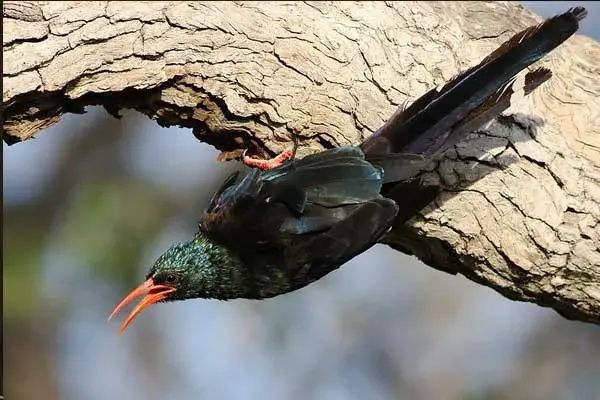
Scientific name: Phoeniculus purpureus
Lifespan: 8-15 years
Wingspan: n/a
Beak Color: Orange-red
Found In: Africa
Green Wood Hoopoe is a large tropical bird native to Africa. It has a metallic dark green plumage, with a purple back and tail. It has a long, decurved, and red-orange bill.
The green wood hoopoe is a carnivorous bird whose diet includes lizards, termites, spiders, caterpillars, etc. When neighboring hoopoe groups meet, they engage in a distinctive “flag-waving” display.
Eclectus Parrot
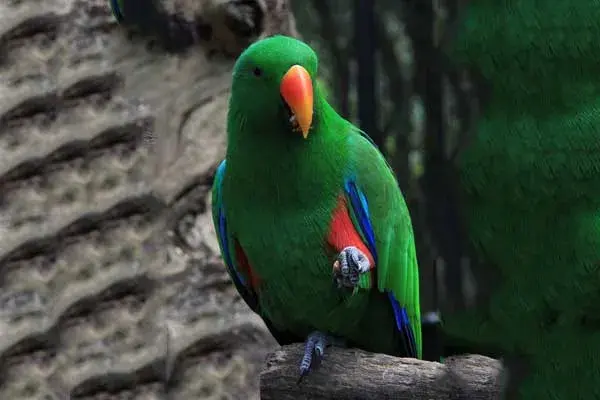
Scientific name: Eclectus roratus
Lifespan: 30-50 years
Wingspan: 34-35 in
Beak Color: Bright orange
Found In: Solomon Islands, Indonesia, New Guinea, northeastern Australia, and the Moluccas
Eclectus parrot is a small parrot native to the Solomon Islands, Sumba, New Guinea, and nearby islands, northeastern Australia, and the Maluku Islands.
Males are generally green with blue primary feathers and red flanks, while females have purple abdomens and red heads and necks. Because of those differences, until the 20th century, people considered them to be separate species.
A healthy male Eclectus parrot will have a bright orange beak – this means that the bird is in good condition.
Eclectus parrots are shy birds that are active during the day and spend most of their time collecting food, eating, and resting. They are great at mimicking human speech and can produce various sounds, including tones, coos, whistles, and laughs.
Bateleur

Scientific name: Terathopius ecaudatus
Lifespan: 27-40 years
Wingspan: 5.5-6 ft
Beak Color: Multicolored (red, orange, black)
Found In: West Africa
Bateleur is a medium-sized eagle with long wings and a very short tail. It has mostly black plumage, with wings that are silver above and white below. Bateleur has a bright red face and legs. This bird of prey has a bill that has a black tip with a yellow-orange center and a red base.
The name Bateleur means “tight-rope walker” in French, referring to its unstable way of flying. They spend about 9 hours a day hunting, and prey on antelope, mice, birds, snakes, carrion, lizards, and especially road kills.
Bateleur can change color depending on its mood – when relaxed, its skin is pale red or orange; when excited, it changes to bright red.
American Goldfinch
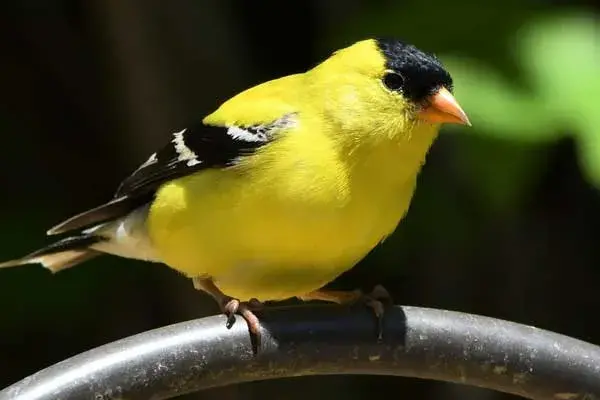
Scientific name: Spinus tristis
Lifespan: 3-6 years
Wingspan: 7.5-8.7 in
Beak Color: Pale orange
Found In: North America
The American goldfinch is a small migratory bird with a small head, long wings, and a short, notched tail.
Male and female American goldfinches have a colorful carotenoid-based orange bill during the breeding season; the bill serves as an indicator of the overall health of the bird. The more saturated with orange a bill is, the higher the testosterone levels are in that specific bird.
This is helpful as it can reduce the chance of a physical battle, risk of injury, and loss of time and energy.
American goldfinches molt twice a year, once in late winter and again in late summer.
These small birds with orange beaks are state birds of New Jersey, Iowa, and Washington.
ʻiʻiwi

Scientific name: Drepanis coccinea
Lifespan: 5-12 years
Wingspan: n/a
Beak Color: Vivid pink-orange
Found In: Hawaiian Islands
The ʻiʻiwi or scarlet honeycreeper is a species of Hawaiian honeycreeper and a symbol of Hawaii. It has a distinctive long curved salmon-orange beak, orange-red feathers, and black wings.
Hawaiian mythology says that the demi-god Maui loved those forest birds so much that he painted them in bright red. He made the ‘iʻiwi especially colorful and gave it a unique call that resonated throughout the forest.
The ʻiʻiwi’s curved beak allows it to get nectar from flowers of the Hawaiian lobelioids, which have decurved corollas.
This orange bird with orange beak is the third most common native land bird in the Hawaiian Islands.
Read More: 18+ white-colored birds in Hawaii
Wattled Curassow

Scientific name: Crax globulosa
Lifespan: 20 years
Wingspan: 36 in
Beak Color: Bright orange with black tip
Found In: South America
The wattled curassow is a large, mostly black, terrestrial bird. It got its name from the bright orange-scarlet knobs and wattles on its bill.
The bird is found in Colombia, Mexico, and Ecuador, in the tropical lowland, riverine and humid forests. Curassow is a threatened species with around 5,000 individuals alive today.
Wattled curassows are omnivores that feed on leaves, fruits, seeds, and small animals such as fish, crustaceans like shrimp, insects, etc.
Read More: Hilarious-looking fish with huge foreheads
Red Lory
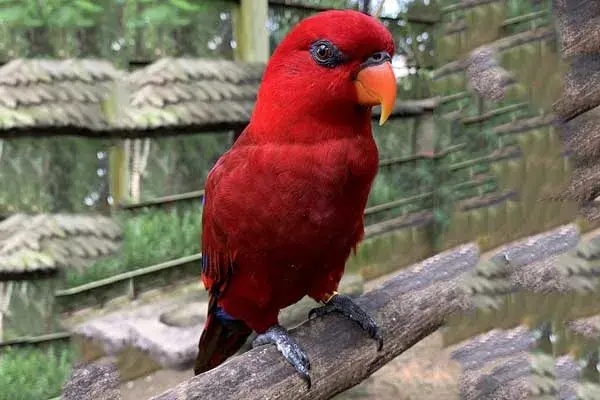
Scientific name: Eos bornea
Lifespan: 15- 30 years
Wingspan: 6.3 in
Beak Color: Bright orange
Found In: Indonesia
The red lory is a small parrot with pomegranate-red plumage and blue markings on its wings and face. The bill is orange.
They are very intelligent and highly active birds and the second-most commonly kept lories in captivity, after the rainbow lorikeet.
Red lories love to talk and will always make noise and thrash their toys in the cage.
These birds with bright orange beaks are native to Indonesia and have a fruit and nectar-based diet.
Common Waxbill
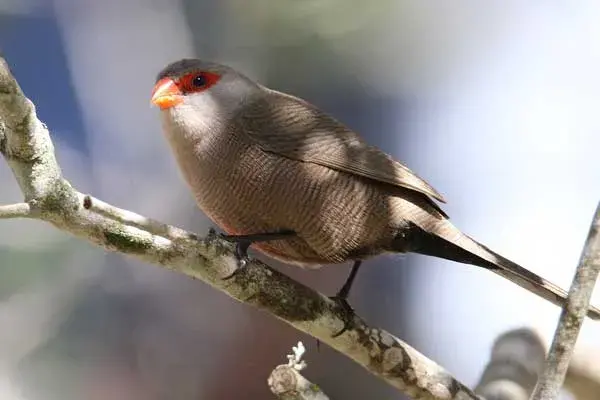
Scientific name: Estrilda astrild
Lifespan: 4 years
Wingspan: 4 in
Beak Color: Red-orange
Found In: Africa
The common waxbill, also known as the St Helena waxbill, is a small bird native to Africa. It has a mostly brown-gray color, with red on the belly and a line through the eyes. Its bill is conical and has a vivid orange-red color.
The waxbill got its name because it appears as if the bird was dipped in red wax.
This bird with an orange beak and grey feathers is very social and can live in flocks of hundreds and thousands of birds.
Common waxbills are omnivores and mostly feed on grass seeds and occasionally insects.
Read More: List of 30+ birds that have the blue color of their heads
Crowned Hornbill
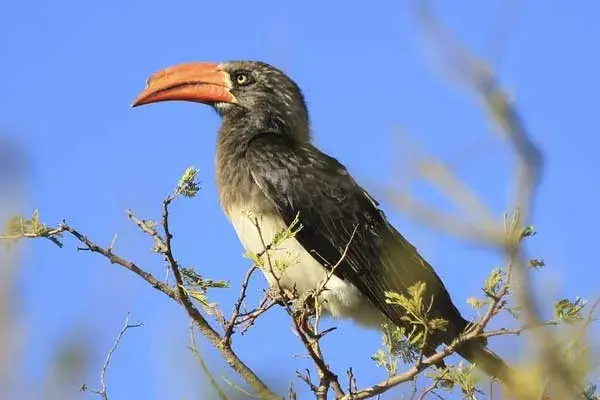
Scientific name: Tockus alboterminatus
Lifespan: 10-15 years
Wingspan: 20 in
Beak Color: Dark orange
Found In: Africa
The crowned hornbill is a medium-sized bird with dark plumage on top, a white belly, and an orange beak. It is native to Africa, in countries like Ethiopia, Angola, Zaire, Kenya, Uganda, Somalia, Zimbabwe, Mozambique, and South Africa.
Crowned hornbills are omnivores and feed on fruits, small birds, lizards, and golden moles. They will eat high on the trees.
Read More: List of Birds With Eyebrows
Great Blue Heron

Scientific name: Ardea herodias
Lifespan: 15 years
Wingspan: 66–79 in
Beak Color: Orange-yellow
Found In: North America
With a wingspan of over 6.5 ft and a length of up to 4.25 ft, great blue herons are the largest North American herons.
You will identify great blue herons by their large yellow-orange beaks, short black plumes on their heads, and black and chestnut pattern on their shoulders.
You can find them around shores of open water and wetlands. Great blue herons tend to hold their necks in an S-shape with their legs trailing behind while flying.
They are monogamous only for a single season and will go through some interesting courtship rituals, locking and rubbing their bills on the feathers of the other bird before mating.
After successful mating, both parents will take turns and incubate the eggs, and after hatching, the chicks can fly at only 2 months of age.
They nest in colonies called heronries that can occasionally have more than 500 nests.
Great blue herons are carnivores that feed on fish, amphibians, reptiles, invertebrates, small mammals, and even other birds.
You can often spot them slowly stalking their prey in shallow waters and catching it with their long and sharp bills.
White-tailed Tropicbird
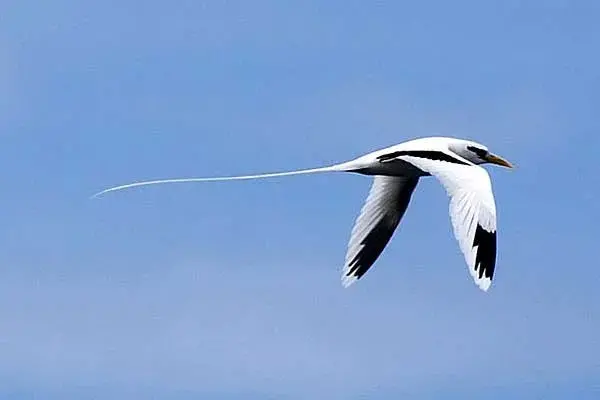
Scientific name: Phaethon lepturus
Lifespan: 10-13 years
Wingspan: 37 in
Beak Color: Orange-yellow
Found In: North, Central, and South America, Africa, Asia, and Australia
White-tailed tropicbird is slender, mainly pearl white bird with a black band on the inner wing. It also has a black eye mask and an orange-yellow beak.
The white-tailed tropicbird is known as Koa’e’kea in Hawaii. It is common throughout the year and can be often seen from boats or the shore.
White-tailed tropicbirds are similar to red-tailed tropicbirds – the main difference is the bill color, pure white back, and black wing bars of white-tailed ones.
They will often hover above the water to detect the prey and dive from 65 ft to catch it. White-tailed tropicbirds feed on flying fish, squid, and crabs.
Semipalmated Plover
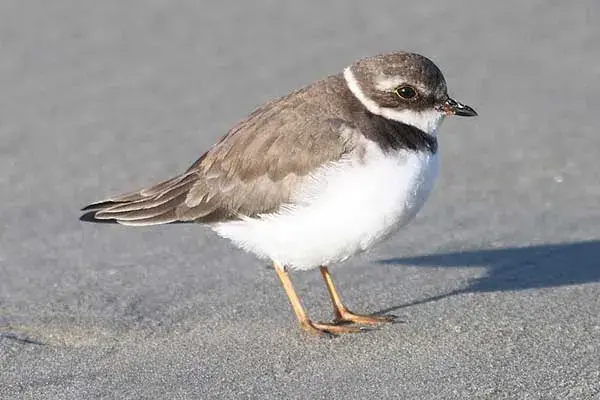
Scientific name: Charadrius semipalmatus
Lifespan: up to 9 years
Wingspan: 14-22 in
Beak Color: Orange and black
Found In: North, Central, and South America, Asia
Another white bird from Hawaii, the semipalmated plover can be found around wetland habitats.
It is easy to recognize by the white color of its underparts, brown upperparts, and black around the eyes. Although it might be hard to see it sometimes, semipalmated plover has a short orange beak with a black tip.
Semipalmated plovers got their name due to the partial webbing on their orange feet.
They feed on insects, crustaceans, and worms, and will perform a “broken-wing” display to lure intruders away from the nest.
Click here if you want to browse a web story with a couple of orange-beaked birds.
Great Egret
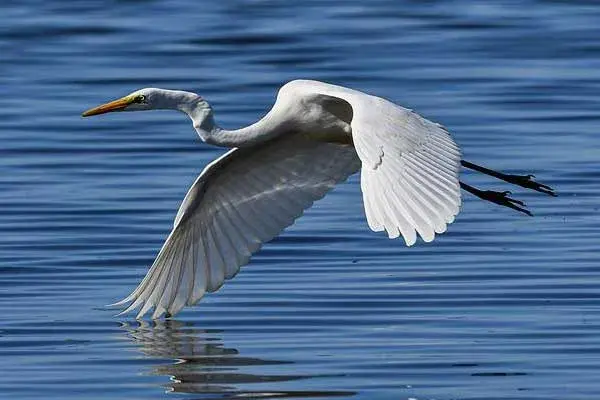
Scientific name: Ardea alba
Lifespan: 22 years
Wingspan: 52-67 in
Beak Color: Orange-yellow
Found In: Asia, Africa, the Americas, and Europe
This impressively large bird has a huge wingspan of up to 67 inches. The great egret is one of the biggest birds in North America and is easy to recognize by its all-white plumage, long yellowish-orange beak, and long black legs.
Great egrets were once hunted for their beautiful plumes called “aigrettes” which were used as hat decoration in the 19th century and almost became extinct. Thanks to several laws and conservational measures, their numbers have since recovered.
They are similar to pelicans because of their blue plumage; great egrets can also tuck their necks right into their backs during flight.
They are seasonally monogamous (stay with the same partner for one breeding season) and breed in colonies in trees close to large lakes. A male great egret will display its mating season plumage and colors and point its beak upward to attract a female.
Great egrets will slowly stalk their prey or stay motionless, waiting for the right moment to strike and impale prey with their long, sharp bills.
They forage in shallow water or drier habitats and mostly feed on fish, frogs, small mammals, small reptiles, crustaceans, and insects.
Make sure to check our list of birds living in Florida with huge bills.
Monk Parakeet
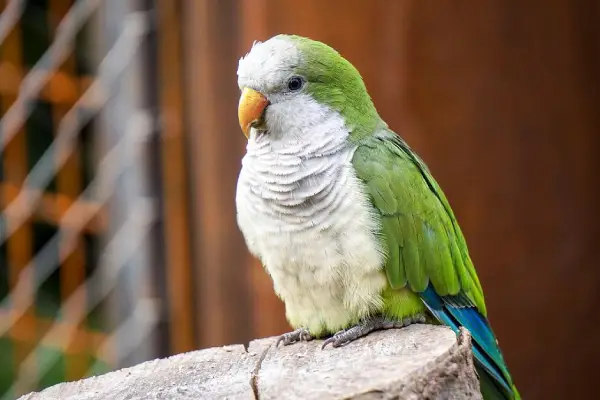
Scientific name: Myiopsitta monachus
Lifespan: 20-30 years
Wingspan: 19 in
Beak Color: Orange
Found In: North and South America
Monk parakeets are small, bright-green parrots that were introduced to Florida and can be now seen year-round in central and southern parts of the state. They were imported from native South America in the 1960s and 1980s and many escaped and got released in the wild.
Today, there are over 150,000 of these green birds in Florida alone.
You will identify monk parakeets by their large green heads, big hooked orange beaks, and long pointed tails. Monk parakeets have bright-green upperparts, grayish breasts, and greenish-yellow abdomens.
They are the only parrots that build a stick nest rather than using a hole in a tree.
Very loud and intelligent, these birds live in small flocks and feed on seeds, nuts, fruits, and greens. Many people keep them as pets due to their charming personalities and their ability to speak.
Golden Crested Myna

Scientific name: Ampeliceps coronatus
Lifespan: 15-20 years
Wingspan: n/a
Beak Color: Pale orange-yellow
Found In: Asia
Golden crested myna is a conspicuous glossy black bird with a pale orange beak and bright yellow head and wings. Males have a more extensive yellow on the head than females. Both sexes have orange beaks.
Their main habitat is subtropical or tropical moist lowland forest, but golden crested mynas can be also found in heavily degraded former forests.
These birds mostly feed on insects and fruits, sometimes on small fish and lizards.
The word “myna” means “bubbling with joy”, coming from a Sanskrit “madana” meaning joyful or delightful, which is derived from the root meaning “bubbles.”
Mallard
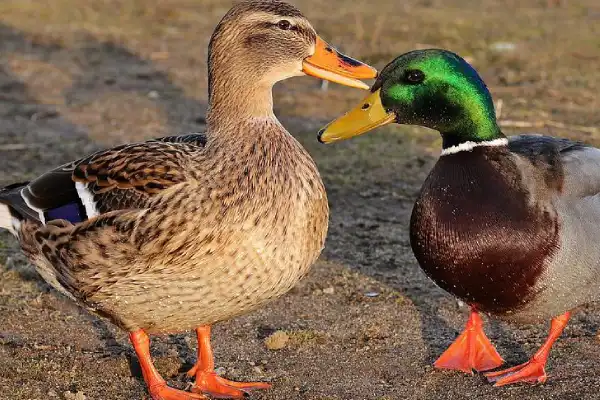
Scientific name: Anas platyrhynchos
Lifespan: 5-10 years
Wingspan: 32-37.4 in
Beak Color: Dark orange in females
Found In: Americas, Eurasia, Australia, and Africa
Mallard is a large duck and the ancestor of nearly all domestic duck breeds. It can be found near shallow ponds and lakes.
They are easy to recognize as males have dark green heads and white collars. Females and juveniles have mottled brown plumage with orange bills with brown spots.
Females make a duck-like quack, males do not. Instead, males produce deeper, raspier one and two-note calls or rattling sounds by rubbing their bills against their flight feathers.
A male Mallard is called a drake and a female is a hen. Mallards fly fast and swim well – they have a 3 ft wide wingspan and can reach a top speed of 70 mph!
These ducks of the American Northeast are omnivorous and eat plants and small fish, insects, frogs, and fish eggs.
Read More: Do Ducks Have Knees?
Red-winged Parrot
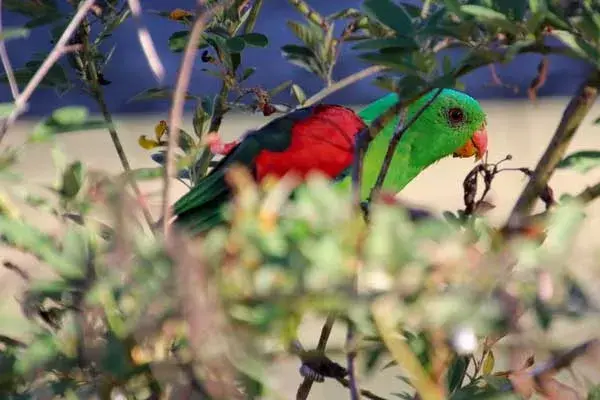
Scientific name: Aprosmictus erythropterus
Lifespan: 30-50 years
Wingspan: n/a
Beak Color: Orange-red
Found In: Australia
This absolutely charming parrot is found in grasslands, savannah, farmland, and woodland of Australia and New Guinea. The red-winged parrot has a bright green head and neck, black upper back and scapulars, and red shoulder patches. Its beak is orange.
As part of their mating ritual, males will circle in a seductive dance around the female, land next to her, and attempt to impress her by flashing their blue rumps.
Red-winged Parrots are omnivores that feed on seeds, nectar, pollen and blossoms, insects, and larvae.
Green Oropendola
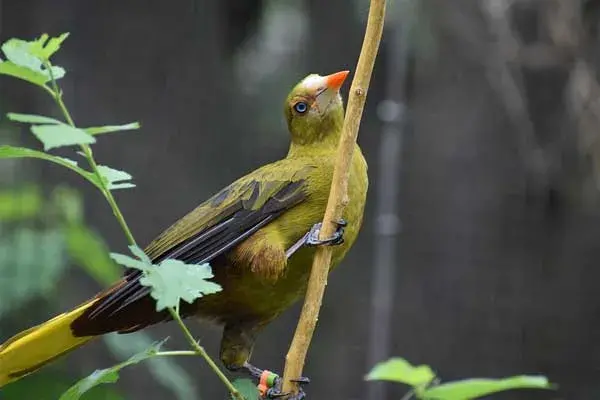
Scientific name: Psarocolius viridis
Lifespan: n/a
Wingspan: n/a
Beak Color: Pale orange
Found In: South America
The green oropendola is a large and stocky bird found in wooded habitats in the Amazon basin and Guianas of South America. It has a mostly bright olive-yellow plumage; the belly, rump, and some underparts are chestnut colored.
Green oropendola has a pale orange beak and blue eyes.
It is a bird that has a largely yellow tail, except for the central rectrices which are black.
Green oropendolas are social birds that are polygamous. During the mating season, to seduce females, males will grab a branch with their feet, bow forward with open wings, hang upside down, and then swings back up to the top of the branch.
These birds are omnivores and feed on insects, fruit, and nectar.
Read More: 25 examples of songbirds of NC
Fuegian Steamer Duck

- Scientific Name: Tachyeres pteneres
- Lifespan: n/a
- Wingspan: 33-43 in
- Beak Color: Bright orange
- Found In: South America
Fuegian steamer ducks, also known as Magellanic flightless steamer ducks, are birds native to South America. These flightless ducks are commonly found on rocky coasts and coastal islands, ranging from Chile to the southernmost part of South America.
They are the largest steamer duck species – they weigh from 7.7 to 15.4 pounds and measure from 26 to 33 inches in length.
Fuegian steamer ducks have a wingspan ranging from 33 to 43 inches but their wings are too small to allow them to fly. Instead, the species uses them as paddles to move across the water.
Fuegian steamer ducks have steely blue-gray plumage and bright orange beaks in southern parts of the continent; those living in southern Chile (around Chiloe Island) have orange beaks with a greenish distal patch.
Males become very aggressive when the breeding season comes and will attack everybody, even other water birds. Some studies suggest that this behavior is part of the pair-bonding ritual.
During winter, they calm down and will even form mixed flocks with other birds.
They might use abandoned penguin nest burrows and lay 4-11 eggs that females incubate for around a month.
Fuegian steamer ducks are carnivores and feed on small fish, mollusks, and crustaceans.
Common Hill Myna

- Scientific name: Gracula religiosa
- Lifespan: 15-20 years in captivity
- Wingspan: n/a
- Beak Color: Bright orange with yellow tip
- Found In: Asia
Common hill mynas are glossy black mynas with bright yellow head wattles.
They are found in mature humid forests and forest edges of South and Southeastern Asia.
Common hill mynas have glossy jet-black plumage, bright orange beaks with yellow tips, and patches of bright orange-yellow skin and fleshy wattles on the side of their heads and napes.
They are very noisy and most vocal around dusk and dawn; identify common hill mynas by their loud high-pitched whistles, wails, screeches, and gurgles.
In the wild, they do not mimic other birds, but in captivity, they are one of the world’s finest. Listen carefully to what they sound when mimicking and notice their beak color.
Common Hill Myna Talking
Sadly, due to their striking black color, orange beaks, and excellent vocal abilities, they are often trapped and sold to private collectors, which results in the decline of their populations.
These social birds love to form small groups of around 6 birds and can be often seen hopping sideways along tree branches.
They are omnivores and feed on insects, fruit, and nectar.
Black Oropendola
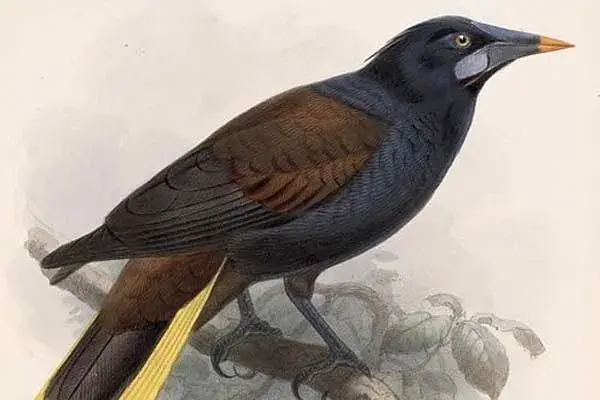
Scientific name: Psarocolius guatimozinus
Lifespan: 20 years
Wingspan: n/a
Beak Color: Orange-red
Found In: Central and South America
The black oropendola is a large bird and a member of the family Icteridae (New World blackbirds). It is found in the subtropical and tropical lowland forests of Colombia and Panama.
It has an overall black plumage, dark brown back and wings, and a dark blue, indigo-colored head. Black oropendola has an orange-tipped beak with a large patch of blue skin at the base. Males and females look pretty much the same.
Black oropendolas are omnivores that feed on insects, small vertebrates, and fruit. They nest colonially, where over 20 birds might build their nest in one tree. Black oropendola’s eggs are pale pink.
Interested in learning more about blue-billed ducks? Check our guide.
Final Thoughts
This concludes our article on 40+ birds with orange beaks.
Many species of parrots like the red lory and rainbow lorikeet, raptors like the bateleur, smaller birds like the American robin, common blackbird, other birds like the Inca tern, mute swan, and Atlantic puffins are just a few that have an orange bill.
Many of these species make wonderful pets, and the tangerine beaks certainly enhance their overall appearance.
Hopefully, the next time you get the chance to see any of these orange-beaked birds in the wild, you will recognize them with ease!
Read more: Animals that closely resemble meerkats and Black birds with orange-colored beaks and Florida birds with orange-colored beaks
Photo Credits
- Green Wood Hoopoe – Derek Keats from Johannesburg, South Africa, CC BY 2.0 https://creativecommons.org/licenses/by/2.0, via Wikimedia Commons (edited)
- Hawaiian honeycreeper – ALAN SCHMIERER from southeast AZ, USA, CC0, via Wikimedia Commons (edited)